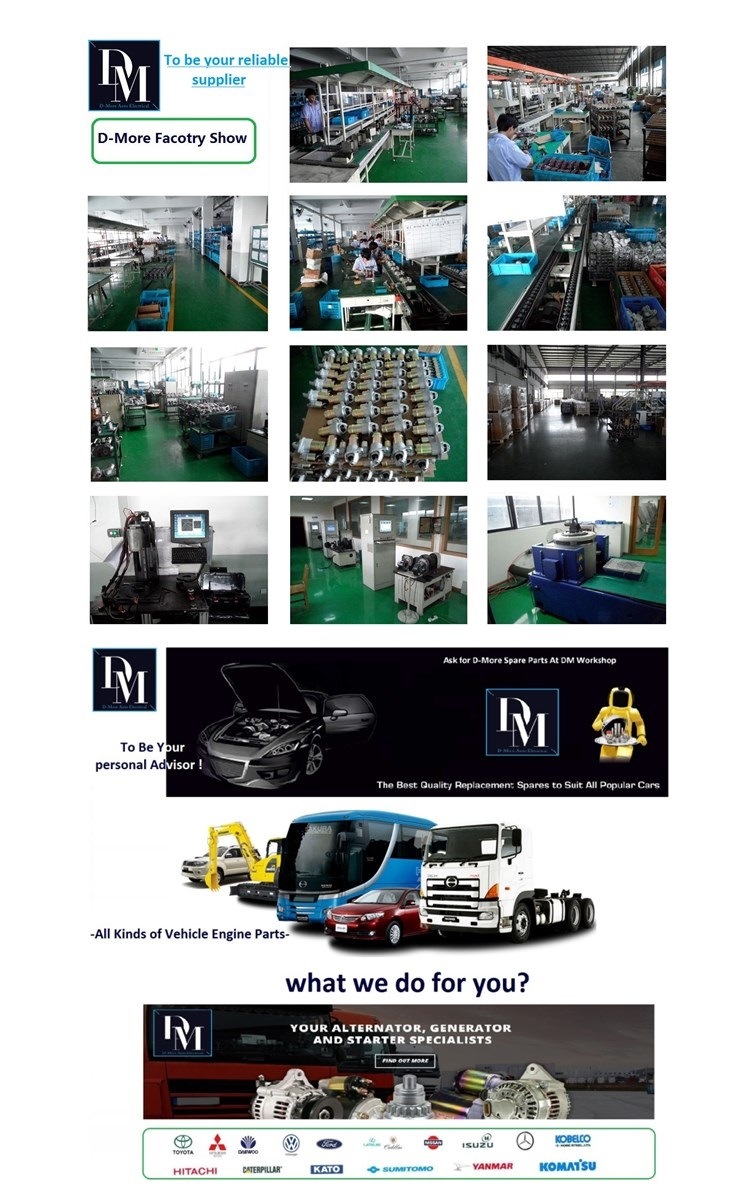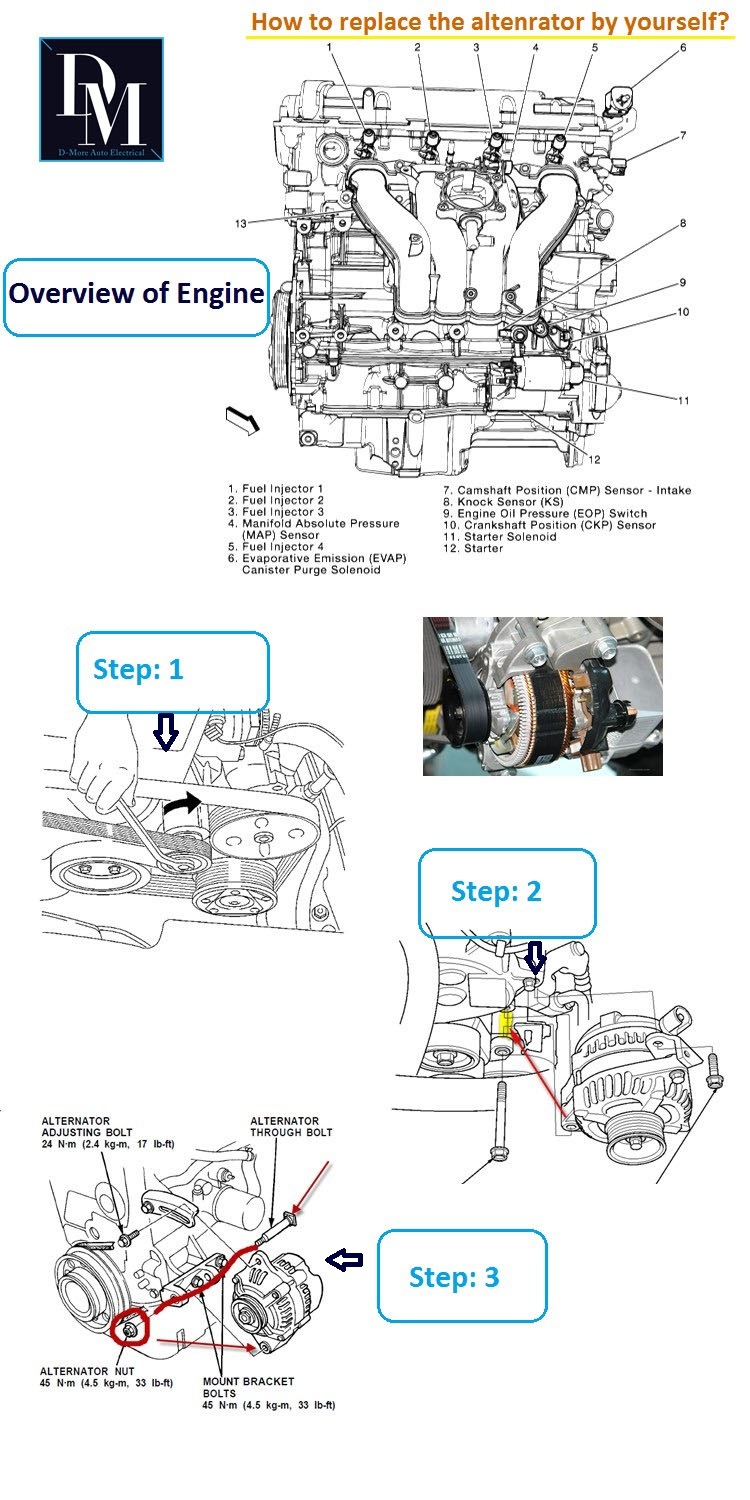
products basic information
| Property | Value |
|---|---|
| Voltage (V) | 12 |
| Amperage (A) | 90 |
| Pulley Type | Fixed |
| Pulley Grooves | 5 |
| Pulley Diameter (mm) | 60 |
| Plug Code | 124 |
| Note 3 | Toyota Yaris |
Cross  referance part numbers
| OEM | OEM Reference | BOM |
|---|---|---|
| DENSO | 1022112770 | Â |
| LUCAS | LRA02860 | Â |
| LUCAS | LRA2860 | Â |
| TOYOTA | 2706033030 |
Vehicle Application:
| Make | Model | Type | Year | Info |
|---|---|---|---|---|
| TOYOTA | YARIS VERSO | 1.4 D-4D (NLP22) | 2001 -Â 2005 | 1364cc, 4cyl, 75HP |
| TOYOTA | YARIS/VITZ | 1.4 D-4D | 2001 -Â 2005 | 1364cc, 4cyl, 75HP |
| TOYOTA | YARIS/VITZ | 1.4 D-4D | 2005 -Â 2005 | 1364cc, 4cyl, 90HP |
| TOYOTA | YARIS/VITZ | 1.4 D-4D | 2005 - | 1364cc, 4cyl, 90HP |
| TOYOTA | YARIS/VITZ | 1.4 D-4D | 2011 - | 1364cc, 4cyl, 90HP |
DM Factory Show:

How replace alternator

Q&A:
1.A: can i get one sample for testing?
   Q: yes! delivery is about 3-5 working days.
2. A: how to deliver the sample?
    Q: DHL or Fedex or UPS or other cheapest ways for the sample
3. A: how long for the production in each order?
   Q: regualr products delivery will be about 35-45 days.
4. A:how about the payment?
    Q: 30% advance payment, 70% against shipment.
5. A: how about the warranty?
   Q: one year after installing the engine.
if any more offers, please contact with me.
DM Contact information:
Oversea Sales dept. Manager: Alex
Mobile:0086.137.7714.6894
Â
Â
 Toyota Yaris 27060-33030 102211-2770 JA1892IR Lester 23860 12V 90A Alternator

products basic information
| Property | Value |
|---|---|
| Voltage (V) | 12 |
| Amperage (A) | 90 |
| Pulley Type | Fixed |
| Pulley Grooves | 5 |
| Pulley Diameter (mm) | 60 |
| Plug Code | 124 |
| Note 3 | Toyota Yaris |
Cross  referance part numbers
| OEM | OEM Reference | BOM |
|---|---|---|
| DENSO | 1022112770 | Â |
| LUCAS | LRA02860 | Â |
| LUCAS | LRA2860 | Â |
| TOYOTA | 2706033030 |
Vehicle Application:
| Make | Model | Type | Year | Info |
|---|---|---|---|---|
| TOYOTA | YARIS VERSO | 1.4 D-4D (NLP22) | 2001 -Â 2005 | 1364cc, 4cyl, 75HP |
| TOYOTA | YARIS/VITZ | 1.4 D-4D | 2001 -Â 2005 | 1364cc, 4cyl, 75HP |
| TOYOTA | YARIS/VITZ | 1.4 D-4D | 2005 -Â 2005 | 1364cc, 4cyl, 90HP |
| TOYOTA | YARIS/VITZ | 1.4 D-4D | 2005 - | 1364cc, 4cyl, 90HP |
| TOYOTA | YARIS/VITZ | 1.4 D-4D | 2011 - | 1364cc, 4cyl, 90HP |
DM Factory Show:

How replace alternator

Q&A:
1.A: can i get one sample for testing?
   Q: yes! delivery is about 3-5 working days.
2. A: how to deliver the sample?
    Q: DHL or Fedex or UPS or other cheapest ways for the sample
3. A: how long for the production in each order?
   Q: regualr products delivery will be about 35-45 days.
4. A:how about the payment?
    Q: 30% advance payment, 70% against shipment.
5. A: how about the warranty?
   Q: one year after installing the engine.
if any more offers, please contact with me.
DM Contact information:
Oversea Sales dept. Manager: Alex
Mobile:0086.137.7714.6894
Â
Â
Â
Casting Polyurethane Prepolymer
Casting Polyurethane Prepolymer used for making wheels, Sieve, machinery parts, sealing ring, PU rollers and other elastomers.
We provide customized products , polyester and polyether in PTMEG/PPG based materials
Casting polyurethane prepolymers involves a process where a liquid mixture of polyols and isocyanates is poured into a mold or container and allowed to cure or solidify. This process is commonly used in various industries such as automotive, construction, and manufacturing.
Here is a step-by-step guide on how to cast polyurethane prepolymers:
1. Prepare the mold: Clean the mold thoroughly and ensure it is free from any debris or contaminants. Apply a mold release agent to facilitate the easy removal of the cured polyurethane.
2. Measure and mix the components: Measure the desired amount of polyol and isocyanate components. The specific ratio will depend on the desired properties of the final product, which can be found in the product's technical data sheet. Pour the measured components into a clean mixing container.
3. Mix the components: Use a mechanical mixer or a high-speed drill with a mixing attachment to thoroughly mix the polyol and isocyanate components together. Make sure to mix for the recommended amount of time specified by the manufacturer to ensure complete homogeneity.
4. Degassing: After mixing, it is important to degas the mixture to remove any trapped air bubbles. This can be done by placing the mixture in a vacuum chamber and applying vacuum pressure for a specified period of time. Alternatively, a vacuum degassing unit can be used.
5. Pouring the mixture: Once the mixture is properly degassed, pour it into the prepared mold or container. Take care to avoid introducing any additional air bubbles during the pouring process.
6. Curing: Allow the poured mixture to cure at room temperature or, if necessary, in a temperature-controlled environment. The curing time will vary depending on the specific polyurethane prepolymer used and the desired hardness or flexibility of the final product. Follow the manufacturer's recommendations for curing time and temperature.
7. Demolding: After the polyurethane has fully cured, carefully remove it from the mold or container. Use caution to prevent any damage to the cured part.
8. Post-curing (optional): Depending on the specific polyurethane prepolymer used, post-curing may be required to optimize the material's properties. This can be done by subjecting the cured part to elevated temperatures for a specific period of time.
It is important to note that casting polyurethane prepolymers requires proper safety precautions, such as wearing appropriate personal protective equipment (PPE) and working in a well-ventilated area. Always follow the manufacturer's instructions and guidelines for handling and working with polyurethane prepolymers.
Good Wheel Polyurethane Prepolymer,Casting Polyurethane Prepolymer,Casting Pu For Elastomers,Custom Polyether Polyurethane Prepolymer
XUCHUAN CHEMICAL(SUZHOU) CO., LTD , https://www.xuchuanpu.com